| Pages:
1
2
3
4
5
6 |
nezza
Hazard to Others
  
Posts: 324
Registered: 17-4-2011
Location: UK
Member Is Offline
Mood: phosphorescent
|
|
Praseodymium sulphate
This is a small crystal of praseodymium sulphate (About 7-8mm long). It appeared slowly (several months) in a solution of the sulphate I made some
time ago.
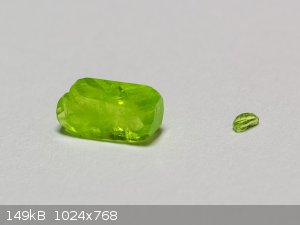
If you're not part of the solution, you're part of the precipitate.
|
|
|
crystal grower
Hazard to Others
  
Posts: 474
Registered: 3-1-2016
Location: Os Petrosum
Member Is Offline
Mood: Puzzled
|
|
Quote: Originally posted by nezza  | This is a small crystal of praseodymium sulphate (About 7-8mm long). It appeared slowly (several months) in a solution of the sulphate I made some
time ago.
|
Really nice. Thanks for posting it here.
|
|
|
aga
Forum Drunkard
    
Posts: 7030
Registered: 25-3-2014
Member Is Offline
|
|
Biggest i've ever seen !
Could you please post the process by which you arrived at that crystal nezza ?
|
|
|
The Volatile Chemist
International Hazard
    
Posts: 1981
Registered: 22-3-2014
Location: 'Stil' in the lab...
Member Is Offline
Mood: Copious
|
|
I've done this, one must add an organic acid (weak acetic) to a solution containing one reactant and Silica gel. When this hardens, add the second
reactant on top and allow to sit until crystallization occurs. One of the products must be less water-soluble than the reactants to crystallize. Done
this w/ copper, lead, Copper(II) hydrogen phthalate, and PbI.
Quote: Originally posted by crystal grower  | Quote: Originally posted by The Volatile Chemist  | | Sodium citrate grows awesome crystals, sort-of hemispherical clusters. Also, Copper(II) Phthalate grows nice deep-blue needle-like crystals, but I
haven't gotten them to grow very large. I got Barium potassium ferrocyanide to grow in granular-size crystals, which were not reported in any of the
books I've found online. They indicate that needle-like rhombohedra form. |
Could you post some pics please?
Anyway thanks for interesting tips. |
U2U me if you get a chance, I can tonight, but will probably forget if you don't.
|
|
|
crystal grower
Hazard to Others
  
Posts: 474
Registered: 3-1-2016
Location: Os Petrosum
Member Is Offline
Mood: Puzzled
|
|
Thanks for answer.
Looking forward to the pics . .
|
|
|
The Volatile Chemist
International Hazard
    
Posts: 1981
Registered: 22-3-2014
Location: 'Stil' in the lab...
Member Is Offline
Mood: Copious
|
|
Na3Cit with some NaOH solution sort-of still around (on them). Except for this, they'd be 'dry' crystals.
These are broken up from their original size (as they formed). They're lying on a blue, transparent clip-board.
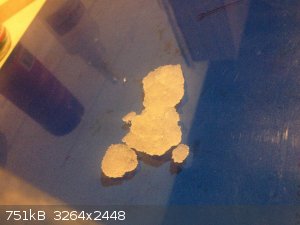
|
|
|
chemrox
International Hazard
    
Posts: 2961
Registered: 18-1-2007
Location: UTM
Member Is Offline
Mood: LaGrangian
|
|
I had a TA that grew a 30# crystal of CuSO4.5H2O in a bathtub. She shaved the dislocations off periodically. Made one big crystal.
"When you let the dumbasses vote you end up with populism followed by autocracy and getting back is a bitch." Plato (sort of)
|
|
|
nezza
Hazard to Others
  
Posts: 324
Registered: 17-4-2011
Location: UK
Member Is Offline
Mood: phosphorescent
|
|
aga. I did not grow the praseodymium sulphate crystal deliberately. It crystallised out of a saturated solution of praseodymium sulphate I had made by
dissolving the metal in dilute sulphuric acid. The solution had been standing for some months and presumably had evaporated somewhat.
If you're not part of the solution, you're part of the precipitate.
|
|
|
crystal grower
Hazard to Others
  
Posts: 474
Registered: 3-1-2016
Location: Os Petrosum
Member Is Offline
Mood: Puzzled
|
|
Quote: Originally posted by The Volatile Chemist  | Na3Cit with some NaOH solution sort-of still around (on them). Except for this, they'd be 'dry' crystals.
These are broken up from their original size (as they formed). They're lying on a blue, transparent clip-board. |
Is that natural color of sodium citrate?
Its pity that NaOH was in excess.
Anyway nice crystals
|
|
|
crystal grower
Hazard to Others
  
Posts: 474
Registered: 3-1-2016
Location: Os Petrosum
Member Is Offline
Mood: Puzzled
|
|
Sodium bisulfate
I had nothing to do yesterday so I decided to grow some new crystals to my collection.
NaHSO4.H2O crystals (prismatic crystals remind me my skoryle - second photo.)
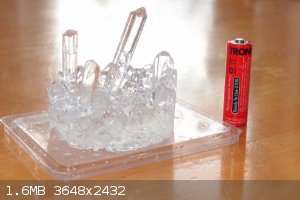 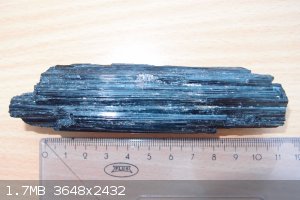
Btw. I've become "hazard to self"    . .
[Edited on 31-1-2016 by crystal grower]
|
|
|
Dmishin
Harmless

Posts: 32
Registered: 5-10-2015
Member Is Offline
Mood: No Mood
|
|
Oh, crystals! I am sorry in advance for picture-loaded post. So, here is a part of my humble collection.
Glucose-NaCl-water cocrystal, 2:1:1 molar ratio
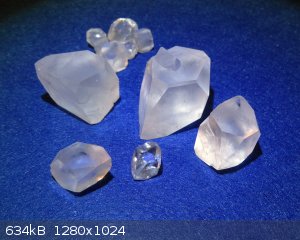
NH4Fe(SO4)2 12H2O and KAl(SO4)2 12H2O
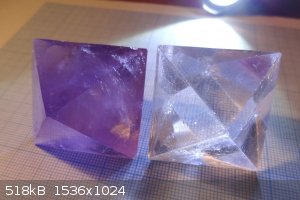
K2Mg(SO4)2 6H2O
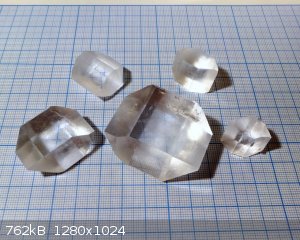
(NH4)2Zn(SO4)2 6H2O
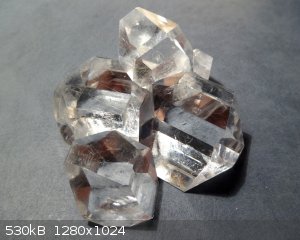
K2SO4
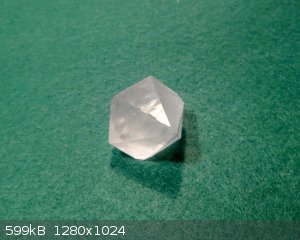
Potassium tris-oxalato aluminate. K3 [Al(C2O4)3]
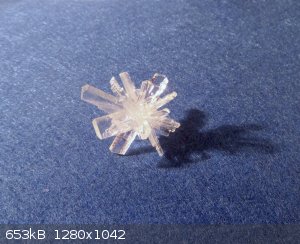
Rochelle salt
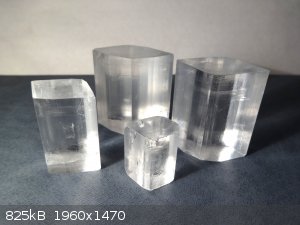
Urea - citric acid 1:1 cocrystal ("urea citrate")
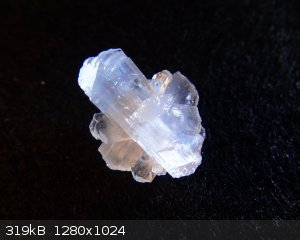
And few more 
All of them grown using evaporation method, without any special equipment.
|
|
|
j_sum1
Administrator
       
Posts: 6320
Registered: 4-10-2014
Location: At home
Member Is Offline
Mood: Most of the ducks are in a row
|
|
I wouldn't be so humble about those. They are gorgeous!
I love the potassium tris-oxalato aluminate.
|
|
|
Velzee
Hazard to Others
  
Posts: 381
Registered: 19-8-2015
Location: New York
Member Is Offline
Mood: Taking it easy
|
|
@Dmishin Oh my—those are so wonderful! How did you make the compounds (not crystals) K2Mg(SO4)2*6H2O and (NH4)2Zn(SO4)2*6H2O?
Check out the ScienceMadness Wiki: http://www.sciencemadness.org/smwiki/index.php/Main_Page
"All truth passes through three stages. First, it is ridiculed. Second, it is violently opposed. Third, it is accepted as being self-evident."
—Arthur Schopenhauer
"¡Vivá Cristo Rey!"
—Saint José Sánchez del Río |
|
|
DraconicAcid
International Hazard
    
Posts: 4333
Registered: 1-2-2013
Location: The tiniest college campus ever....
Member Is Offline
Mood: Semi-victorious.
|
|
Quote: Originally posted by Velzee  | | @Dmishin Oh my—those are so wonderful! How did you make the compounds (not crystals) K2Mg(SO4)2*6H2O and (NH4)2Zn(SO4)2*6H2O?
|
I imagine they'd be made the same way as I made (NH4)2Mg(SO4)2*6H2O. Mix ammonium sulphate and
magnesium sulphate in a one-to-one mole ratio, and dissolve in a minimum of water. Allow to evaporate.
A similar method worked for (NH4)2Ni(SO4)2*6H2O but not
(NH4)2Cu(SO4)2*6H2O
Please remember: "Filtrate" is not a verb.
Write up your lab reports the way your instructor wants them, not the way your ex-instructor wants them.
|
|
|
The Volatile Chemist
International Hazard
    
Posts: 1981
Registered: 22-3-2014
Location: 'Stil' in the lab...
Member Is Offline
Mood: Copious
|
|
Quote: Originally posted by crystal grower  | Quote: Originally posted by The Volatile Chemist  | Na3Cit with some NaOH solution sort-of still around (on them). Except for this, they'd be 'dry' crystals.
These are broken up from their original size (as they formed). They're lying on a blue, transparent clip-board. |
Is that natural color of sodium citrate?
Its pity that NaOH was in excess.
Anyway nice crystals |
Oh, no, sorry, they're sitting on a blue clipboard. They're a sort-of rocky milk-white.
|
|
|
Dmishin
Harmless

Posts: 32
Registered: 5-10-2015
Member Is Offline
Mood: No Mood
|
|
Mixing simple sulfates in stoichiometric proportions in aqueous solution, then crystallizing. But actually, since these double compounds are often
less soluble than single salts, it is often enough to mix any salts, providing enough required ions.
I made a batch of K2Mg(SO4)2*6H2O by mixing KCl and MgSO4 and evaporating, by the equation:
2KCl + 2Mg2SO4 + 6H2O -> K2Mg(SO4)2*6H2O (s) + MgCl2 (aq)
I also make alum by mixing NH4NO3 (that's crazy, but it is the most obtainable source of ammonium ions for me) and Al2(SO4)3.
|
|
|
Dmishin
Harmless

Posts: 32
Registered: 5-10-2015
Member Is Offline
Mood: No Mood
|
|
I wonder why. I tried this in mini-test (few ml of solution), and observed light-blue tabular crystals, clearly different from the pure CuSO4*5H2O.
|
|
|
crystal grower
Hazard to Others
  
Posts: 474
Registered: 3-1-2016
Location: Os Petrosum
Member Is Offline
Mood: Puzzled
|
|
Quote: Originally posted by Dmishin  | Oh, crystals! I am sorry in advance for picture-loaded post. So, here is a part of my humble collection.
Glucose-NaCl-water cocrystal, 2:1:1 molar ratio
NH4Fe(SO4)2 12H2O and KAl(SO4)2 12H2O
K2Mg(SO4)2 6H2O
(NH4)2Zn(SO4)2 6H2O
K2SO4
Potassium tris-oxalato aluminate. K3 [Al(C2O4)3]
Rochelle salt
Urea - citric acid 1:1 cocrystal ("urea citrate")
And few more 
All of them grown using evaporation method, without any special equipment. |
They are awesome !
I must try the rochelle salt too.
|
|
|
DraconicAcid
International Hazard
    
Posts: 4333
Registered: 1-2-2013
Location: The tiniest college campus ever....
Member Is Offline
Mood: Semi-victorious.
|
|
Quote: Originally posted by Dmishin  |
I wonder why. I tried this in mini-test (few ml of solution), and observed light-blue tabular crystals, clearly different from the pure CuSO4*5H2O.
|
I got more clusters of crystals than observable single crystals. I'll try again.
Please remember: "Filtrate" is not a verb.
Write up your lab reports the way your instructor wants them, not the way your ex-instructor wants them.
|
|
|
Velzee
Hazard to Others
  
Posts: 381
Registered: 19-8-2015
Location: New York
Member Is Offline
Mood: Taking it easy
|
|
@Dmishin, I attempted to make K2Mg(SO4)2*6H2O, as per your method of adding the reactants in stoichiometric amounts(~33 grams of
MgSO4*7H2O dissolved into ~100mL of hot distilled water, and 10 grams of KCl dissolved into ~50mL of hot distilled water) into a suitable container,
and then boiling the solution down, then allowing it to evaporate. The crystals that formed were a bit uneven, but, nevertheless, beautiful:
https://i.imgur.com/BAySBci.jpg
As you can see, the crystals do not look like the ones you posted. Whether or not they are K2Mg(SO4)2*6H2O, I'm not sure. I
have many more crystals of similar size; I'm in the process of coating them with clear nail polish in order to protect them.
[Edited on 2/5/2016 by Velzee]
[Edited on 2/5/2016 by Velzee]
Check out the ScienceMadness Wiki: http://www.sciencemadness.org/smwiki/index.php/Main_Page
"All truth passes through three stages. First, it is ridiculed. Second, it is violently opposed. Third, it is accepted as being self-evident."
—Arthur Schopenhauer
"¡Vivá Cristo Rey!"
—Saint José Sánchez del Río |
|
|
Dmishin
Harmless

Posts: 32
Registered: 5-10-2015
Member Is Offline
Mood: No Mood
|
|
Quote: Originally posted by Velzee  |
As you can see, the crystals do not look like the ones you posted. Whether or not they are K2Mg(SO4)2*6H2O, I'm not sure.
|
I see the opposite: the crystal at the top definitely look the same. Look, I drew similar edges with red.
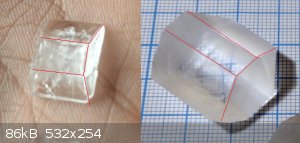
The difference is because your was grown quickly on the bottom of the vessel, and mine were grown slowly, suspended on a thread in the middle of
solution and have all edges fully developed.
I think, this compound is not prone to dehydration, so covering is not required.
Of the above specimens, only ferric alum and potassium oxalato aluminate require protection (I store them in a tightly closed container though).
Others are stored on air and haven't changed in months.
|
|
|
Pumukli
National Hazard
   
Posts: 705
Registered: 2-3-2014
Location: EU
Member Is Offline
Mood: No Mood
|
|
How do you suspend a small crystal on a thread? I mean, I always had the impression that the thread , the knot, the touching surfaces will cause
growth errors and anything but malformed crystals would result. It is apparently not the case but I don't know why?
Anyone knows the answer?
|
|
|
crystal grower
Hazard to Others
  
Posts: 474
Registered: 3-1-2016
Location: Os Petrosum
Member Is Offline
Mood: Puzzled
|
|
Quote: Originally posted by Pumukli  | How do you suspend a small crystal on a thread? I mean, I always had the impression that the thread , the knot, the touching surfaces will cause
growth errors and anything but malformed crystals would result. It is apparently not the case but I don't know why?
Anyone knows the answer?
|
Try to heat the solution a little and add the salt to make it saturated.
Then put inside the thread ( I prefer nylon ) and let it slowly cool down.
When the solution is already cooled, there should be small crystals attached on the thread. The best looking crystal of them should be used for
crystal growing while the rest of the crystals must be removed.
The goal of this procedure is a seed crystal attached on the thread without need of tying it .
I hope this will help you  . .
|
|
|
Dmishin
Harmless

Posts: 32
Registered: 5-10-2015
Member Is Offline
Mood: No Mood
|
|
@Pumukli
I usually just tie them. With some luck, if the thread is thin and smooth enough, it forms no additional crystallization centers, and knot submerges
seamlessly into the growing seed. Method described by crystal grower (waiting until appropriate seeds naturally appear on a thread) also works and
gives even better results, but is a bit unpredictable.
I photographed my process of attaching seed (of glucose-NaCl cocrystal) for a reddit thread, take a look: http://imgur.com/a/3h2Gf
At the moment, seed on the last photo doubled in size, and the knot is inside.
|
|
|
crystal grower
Hazard to Others
  
Posts: 474
Registered: 3-1-2016
Location: Os Petrosum
Member Is Offline
Mood: Puzzled
|
|
This one is NaHSO4.10H2O crystal made by cooling the solution.
I u want simply and quickly made crystals I could only recommend this one. Only but quite serious con is that this stuff is very hygroscopic and can
be easily dehydratated.
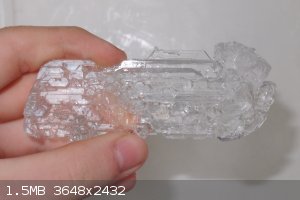 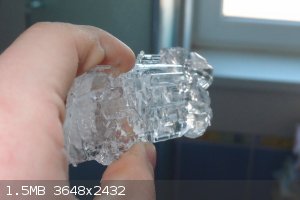
|
|
|
| Pages:
1
2
3
4
5
6 |